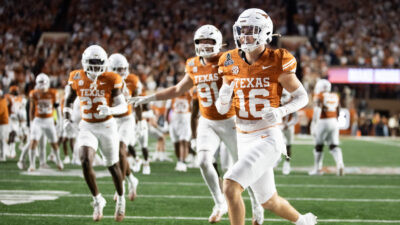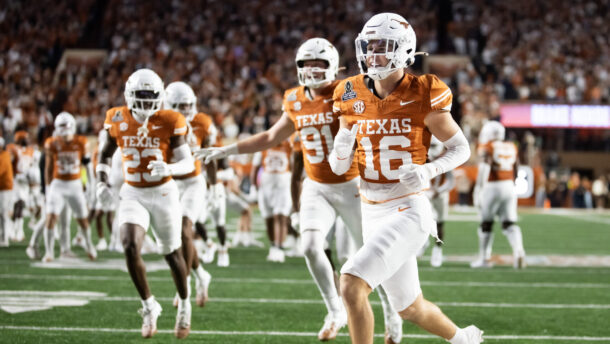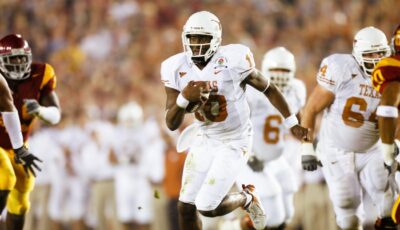
Not everyone can improve. It’s a sad fact of life. As I’ve gotten older, I’ve accepted that there are certain things I’ll never improve in again. For starters, my height. Having been 5-8 since my freshman year of high school, I accepted that I plateaued long ago. My odds of dunking a basketball became nonexistent once I realized that 5-8 was as tall as this frame was getting.
Fortunately for a bunch of SEC offenses, they aren’t facing the same uphill climb that I did. Many have room for improvement. Only 4 of them finished in the top 30 in FBS. Half of the conference finished between No. 48-80 in FBS.
Improvement isn’t strictly associated with returning a starting quarterback, though obviously it helps. That’s why teams such as Alabama and Tennessee can always make that case. The question about both programs is whether they can prove after they put up an average of 39.9 and 39.3 points, respectively.
On the flip side, just because Vandy’s only way to go is up doesn’t mean that I’m sold on that offensive line playing well enough to yield any improvement.
Improvement can come in a variety of forms. Better quarterback situation? Fewer injuries? New offensive play-caller? All can be contributing factors.
These are the 5 SEC offenses that are destined for improvement in 2022:
(Keep in mind that not being on this list is NOT necessarily a sign that regression is imminent. It just means I might have more questions or I’d probably only predict a tiny improvement.)
South Carolina
2021 finish — 22.6 PPG (No. 104 in FBS)
Why improvement is imminent — I know. The offensive has to get better. It doesn’t matter if you have 4 starters back. It has to improve. But yes, bringing in Spencer Rattler and not starting a grad assistant will pay dividends for South Carolina. That’s not a shot at Zeb Noland, who performed well in limited reps. But South Carolina started 3 quarterbacks behind a bad offensive line with a new scheme. How do you think it went? The Gamecocks now get another year in Marcus Satterfield’s scheme, which was much improved down the stretch. Jaheim Bell, Austin Stogner, Josh Vann, DK Joyner, Marshawn Lloyd and FCS transfer Antwane Wells should help turn a bottom feeder group around in a hurry. South Carolina should improve by at least a touchdown per game.
LSU
2021 finish — 26.5 PPG (No. 80 in FBS)
Why improvement is imminent — In 2021, LSU’s offense:
- A) Lost its best offensive player to a season-ending injury midseason
- B) Had a disastrous running game for the majority of the year
- C) Had a first-time offensive play-caller
- D) Suffered a midseason coach firing
- E) All the above
The answer is always “E, all of the above.” That’s not exactly a model for success against SEC West defenses. As a result, LSU had the worst offense in the division and finished No. 12 out of 14 SEC offenses. So why will that be better? Well, besides the fact that it’s a new coaching staff with an offensive-minded head coach in Brian Kelly, LSU is loaded with promising options at quarterback, including a healthy Myles Brennan and coveted transfer Jayden Daniels. The receiver room could be the SEC’s best if Kayshon Boutte is on the field and the ground game now has an eligible John Emery and a healthy Noah Cain from Penn State. I refuse to believe that LSU can be as bad as it was offensively last year when outside of a major Max Johnson injury, it felt like everything went wrong.
Mississippi State
2021 finish — 29.1 PPG (No. 60 in FBS)
Why improvement is imminent — I’m admittedly a bit hesitant to say that improvement is imminent when I have concerns about the blind-side protection in a post-Charles Cross world and I fear that Will Rogers will start forcing throws without go-to target Makai Polk.
But I do like the fact that Rogers improved significantly in 2021, yet he finished the season with 2 rough outings. Something tells me that lights a fire under him heading into Year 3. He has help, too. MSU returns 72% of its offensive production, including the majority of that offensive line, the backfield duo of Dillon Johnson and Jo’quavious Marks, ageless receiver Austin Williams and Jaden Walley. On top of that, Mike Leach added a pair of Power 5 receiver transfers in Justin Robinson (Georgia) and Jordan Mosley (Northwestern). MSU averaged 37 points per game in November. I’m optimistic we see more of that group instead of the one that couldn’t score against Texas Tech.
Texas A&M
2021 finish — 29.3 PPG (No. 56 in FBS)
Why improvement is imminent — Don’t get it twisted. I still have my fair share of questions about the A&M offense, mainly if there’s enough depth with the non-Ainias Smith pass-catcher options. But I’m bullish on this being an improved group for a few reasons. One is that I think offensive line play will be better across the board, even though Kenyon Green is off to the NFL (he was Jimbo Fisher’s first Round 1 guy at A&M). As we saw with the Maroon Goons in 2020, that depth and experience is pivotal. Devon Achane doesn’t need a large crease to be that home-run hitter. But whether it’s Haynes King or Max Johnson, there’s no reason the Aggies should struggle so much with passing efficiency like they did with Zach Calzada in 2021. A&M ranked No. 99 in FBS with 6.8 yards per pass attempt. Even if Johnson or King aren’t elite downfield passers, that number should improve. As a result, so will the A&M offense.
Tennessee
2021 finish — 39.3 PPG (No. 7 in FBS)
Why improvement is imminent — Hold up. Improvement is imminent for the No. 7 offense in FBS? You better believe it. Remember that Hendon Hooker wasn’t QB1 to start the year. Once he took over for Joe Milton, that offense soared in typical Josh Heupel fashion.
- September: 35.5 PPG (No. 37 in FBS)
- October: 39.3 PPG (No. 13 in FBS)
- November: 41.8 PPG (No. 10 in FBS)
Heupel posted his 4th consecutive top-10 offense. With an elite returning starting quarterback and a bevy of talented skill-player options, why wouldn’t they take another step within the top 10? Hooker gets a full offseason with first-team reps, and there’s familiarity in the system. Tennessee put up those prolific numbers despite the fact that Hooker took 36 sacks. I can’t help but think a unit with more stability — the Vols return 80% of their offensive production — is going to take another step forward, especially if the defense takes a step back. Ohio State and Alabama are the obvious picks to have the nation’s top offense, but don’t sleep on the Vols.
Wait … no Alabama? And why not Georgia?
I don’t think Alabama or Georgia regress on offense. But let’s not forget that the Tide finished No. 6 in FBS while UGA came in only a few spots behind at No. 9. While I’m extremely high on the Tide’s skill-player additions via the transfer portal, I still have concerns about that offensive line. I wonder if that coupled with my belief that Alabama’s defense will be lights out prevents any significant improvement. Alabama might not need to keep its foot on the gas so late in games like last year, when it was in a 1-score game in 6 of 8 4th quarters in SEC play.
I’ll be honest. When I started this, I assumed I’d have UGA as 1 of the 5 teams. Returning Stetson Bennett matters, as does the fact that UGA should have the top tight end room in the nation. Todd Monken will create mismatches galore with Brock Bowers, Arik Gilbert, Darnell Washington and even true freshman Oscar Delp. On top of that, Kendall Milton and Kenny McIntosh have all sorts of potential to lead one of the SEC’s top backfields.
So what’s the holdup? I wonder how much last year’s group was boosted statistically by having that elite defense. In addition to the defensive scores, think about all the short fields that all-generation group created. UGA could actually become more explosive offensively and still end up finishing right around where it did last year.
Connor O'Gara is the senior national columnist for Saturday Down South. He's a member of the Football Writers Association of America. After spending his entire life living in B1G country, he moved to the South in 2015.







